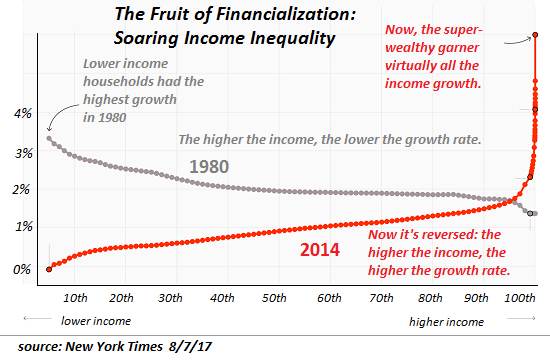
The equity, property and bond markets all rode the coattails of the Fed’s ZIRP and easy-money liqudiity tsunami for the past 13 years. As those decrease, what’s left to drive assets higher?
No surprise the marketplace is skittish:
1. Each time the Federal Reserve began to taper quantitative relieving/ open spigot of liquidity over the previous decade, lower its balance sheet or raise rates from near-zero, the market plummeted (“taper temper tantrum”) and the Fed stopped tightening and returned to easy-money growth.
2. Now the Fed is boxed in by inflation– it can’t continue the bubblicious easy-money policies, nor does it have any space left to lower rates due to its pinning interest rates to near-zero for years.
3. So market individuals (a.k.a. punters) are nervously wondering: can the U.S. economy and the Fed’s property bubbles endure higher rates and the spigot of liquidity being switched off?
4. The market is likewise wondering if the economy can survive the pricking of the “everything” asset bubbles in stocks, bonds, real estate, etc as rate of interest increase and liquidity is withdrawn. What remains of “growth” once the top 10% no longer see their wealth broaden on a monthly basis like clockwork?
5. The unprecedented growth of property evaluations driven by expansions of credit and liquidity (i.e. affordable credit chasing limited assets) has considerably increased the wealth of the leading 10% (particularly the wealth of the top 0.1% and top 1%). Considering that the top 10% gather about half of all earnings and represent approximately half of all consumer spending, the “wealth impact” produced by ever-rising possession assessments has actually underpinned “development” in both asset purchases and usage.
If properties really decline in worth and the wealth result reverses (i.e. punters feel poorer), then what will drive expansion of capital and costs moving forward?
6. The Federal Reserve and U.S. Treasury have actually institutionalized moral risk, the disconnect of risk and effect, for America’s financial elite: instead of force those who gambled and lost to take in the losses in 2008-09, the Fed and Treasury bailed out the too huge to fail, too huge to prison financial elite, establishing an unmentioned policy of motivating the most affluent individuals and enterprises to obtain and gamble freely, understanding they could keep any earnings (and pay low or no taxes on the gains) and transfer any losses to the Fed and/or taxpayers.
7. This institutionalization of moral danger integrated with absolutely no rates of interest policy (ZIRP) and an open spigot of liquidity has driven wealth and earnings inequality to extremes that are economically, politically and socially destabilizing. Expert trading in the Fed and Congress has finally leached out into the public sphere, and the relaxing enrichment of the already super-wealthy has actually now reached extremes that welcome destabilizing blowback.
8. As noted here just recently, inflation is now ingrained due to structural, cyclical modifications in supply chains and the labor market: instead of importing deflation, worldwide supply chains now import inflation (higher costs) and deficiencies. After being stripmined of $50 trillion over the previous 45 years, labor has actually finally gained some take advantage of to claw back a little bit of the acquiring power that has been surrendered to corporations and finance over the past 2 generations.
9. Inflation spirals out of control if the expense of credit (interest rates) do not increase to reward capital with inflation-adjusted income: if inflation is 6% yearly, a bond paying 1% loses 5%. This is not sustainable, for it misshapes the prices of danger.
10. As rates rise, lower-risk bonds end up being more appealing than dangerous stocks, and capital leaves stocks for income-producing securities. Increasing rates are traditionally bad for stocks, so what will keep stock markets lofting greater if rates rise, liquidity is lowered and capital exists dangerous stocks?
11. The stock exchange is overvalued by traditional steps of worth, and any mean reversion will decrease the market substantially. So what’s delegated push danger possessions greater? The only answers with any substance are: A) rising revenues due to companies having prices power in an inflationary environment and employees getting more buying power so they can pay for to pay higher prices and B) massive inflows of global capital due to perceptions of lower danger and higher returns in U.S. dollar denominated properties. If neither transpires, there’s no real assistance for stocks to continue lofting ever greater.
12. The equity, realty and bond markets all rode the coattails of the Fed’s ZIRP and easy-money liquidity tsunami for the past 13 years. As those diminish, what’s delegated drive assets greater? It’s an open question, therefore skittishness is logical and prudent.
In summary: by fulfilling financialization and the largest concentrations of capital at the expense of labor, small company and productivity, the Federal Reserve and federal/ state governments have actually made the economy and society precariously dependent on possession bubbles, corruption (pay to play politics) and monetary trickery. The only real foundation for growth is to expand the circulation of gains in productivity, move the gains from capital to labor and reward small investment in performance gains instead of funnel all the gains into possession bubbles and financialized casinos that improve the leading 0.1% at the expense of the country and its individuals.


My new book is now offered at a 20 % discount this month: Global Crisis, National Renewal: A(Revolutionary)Grand Strategy for the United States(Kindle$8.95, print$20)If you discovered value in this content, please join me in seeking solutions by becoming a$1/month client of my work by means of patreon.com. Recent Videos/Podcasts: Charles Hugh Smith on Why Many are Resigning From Their Jobs (35 minutes, with Richard
Bonugli )My current books: International Crisis, National Renewal: A(Revolutionary)Grand Method for the United States (Kindle$9.95, print$25)ReadChapter One for free(PDF ). A Hacker’s Teleology
: Sharing the Wealth of Our Shrinking Planet(Kindle $8.95, print $20, audiobook$17.46)Check out the very first area
totally free(PDF). Will You
Be Richer or Poorer?: Profit, Power, and AI in a Distressed World (Kindle $5, print $10, audiobook)Read the first section totally free
(PDF). Pathfinding our Destiny: Preventing the Last Fall of Our Democratic Republic ($ 5 Kindle,$10 print,(audiobook): Check out the very first area for free(PDF). The Experiences of the Consulting Thinker: The Disappearance of Drake$1.29 Kindle,$8.95 print); read the first chapters for free(PDF)Cash and Work Unchained$6.95 Kindle, $15 print )Check out the very first area for free End up being a$1/month customer of my work via patreon.com. NOTE: Contributions/subscriptions are acknowledged in the order received. Your name and e-mail stay private and will not be given to any other individual, company or company. Thank you, Betty W.($100), for your outrageously generous contribution to this site– I am considerably honored by your unfaltering support and readership. Thank you, Robert J. ($108), for your outrageously generous contribution to this site– I am considerably honored by your unfaltering assistance and readership.

